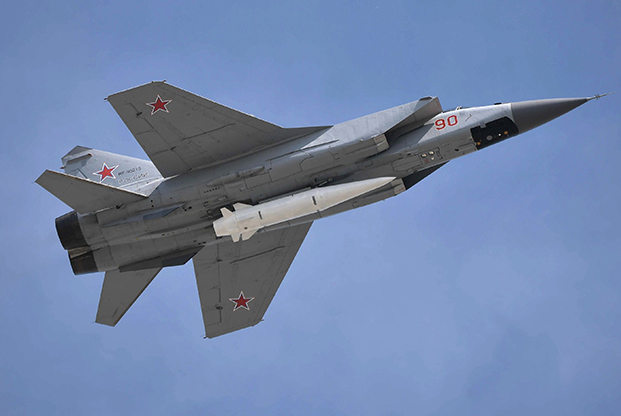
Russian air-launched Kinzhal hypersonic missile carried on a MiG-31. A former deputy director of the Missile Defense Agency on Tuesday sai the US needs to more quickly develop a defense against these weapons, as Russia and China move forward in the development of hypersonic missiles. Russian Ministry of Defense photo.
The former deputy director of the Missile Defense Agency on Tuesday called on US officials to quickly move to develop a defense against hypersonic weapons.
Kenneth Todorov, a former Air Force brigadier general and now Northrop Grumman’s vice president of missile defense solutions, told a Mitchell Institute breakfast in Washington, D.C., that the current US ballistic missile defense system is “really not arrayed” for the hypersonic threat.
“Our current array of sensors, effectors, command-and-control? networks, are not … designed or capable to deal with this threat,” said Todorov, who was the MDA deputy director from 2014-15.
“Those systems weren’t designed at the outset for it, they weren’t developed, they’re not tested—although we’re starting to test our systems for hypersonic threat, but in a very sort of basic way,” he said.
“But I think all would agree that our systems today are insufficient to deal with it,” he said.
To respond, he said, the US must act quickly with a solution that must “start with space,” with assets able to acquire and track targets and take action, and must include a new effector, possibly including offensive hypersonic capabilities. It must also take employ capabilities to deal with hypersonic vehicles in different ways, “but it needs to be layered, because I think one approach in and of itself is not going to be sufficient.”
In addition he said, non-kinetic means should be considered, pointing to discussions about boost-phase intercepts, directed energy, and electronic warfare means to counter hypersonic threats.
Finally, he said this must be done rapidly.
“Hypersonic defense cannot be a program that we envision in 2030 and 2035, this huge, behemoth kind of program,” he said. “The threat is real and it’s here today, and our adversaries continue to develop it in a really real way, so this can’t be a program that exists in 2030 or 2035. We’ve got to be able to take existing technologies and apply them to the counter-hypersonics equation.”
“And, I think, because of that, we can do this in an affordable way.”